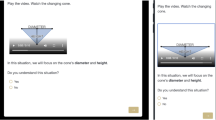Abstract
This paper discusses the growth of mathematical understanding of two students, Graham and Don, as they use a computer graphing program to explore the properties of quadratic equations. Through analysing extracts of video data using the Pirie-Kieren theory, we discuss the ways in which the mathematical understanding of the students grows and how their interactions occasion, facilitate, and restrict this. We consider four ‘clips’ of their mathematical working, highlighting different aspects of their developing understanding, and use of the graphing software. Although we are talking about a computer based graphing package, our conclusions are equally relevant to the use of graphing calculators.
Similar content being viewed by others
References
Borba, M.C., & Villarreal, M.E. (1998). Graphing calculators and reorganization of thinking: The transition from functions to derivative. In A. Olivier & K. Newstead (Eds.),Proceedings of the 22nd annual conference of the International Group for the Psychology of Mathematics Education (Vol. 4, pp. 120–127). Stellenbosch, South Africa: Program Committee.
Carulla, C., & Gomez, P. (1997). Graphics Calculators and problem solving. Do they help? In E. Pehkonen (Ed.),Proceedings of the 21st annual conference of the International Group for the Psychology of Mathematics Education (Vol. 1, p. 224). Lahti, Finland: Program Committee.
Davis, B. (1996).Teaching mathematics: Toward a sound alternative. New York: Garland.
Elliott, S., & Hudson, B. (2000). Visualisation and the influence of technology in ‘A’ level mathematics: A classroom investigation. In T. Rowland & C. Morgan (Eds.),Research in Mathematics Education (Vol. 2, pp. 151–168). London: BSRLM.
Hong, Y.Y., & Thomas, M. (1997). Using the computer to improve conceptual thinking in integration. In E. Pehkonen (Ed.),Proceedings of the 21st annual conference of the International Group for the Psychology of Mathematics Education (Vol. 3, pp. 81–88). Lahti, Finland: Program Committee.
Martin, L. (1999).The nature of the folding back phenomenon within the Pirie-Kieren Theory for the growth of mathematical understanding and the associated implications for teachers and learners of mathematics. Unpublished doctoral dissertation, Oxford University, UK.
Mesa, V. (1997). The use of graphing calculators in solving problems on functions. In E. Pehkonen (Ed.),Proceedings of the 21st annual conference of the International Group for the Psychology of Mathematics Education (Vol. 3, pp. 240–247). Lahti, Finland: Program Committee.
Penglase, M., & Arnold, S. (1996). The graphics calculator in mathematics education: A critical review of recent research.Mathematics Education Research Journal, 8(1), 58–90.
Pirie, S. E. B., & Kieren, T. (1992). The answer determines the question — interventions and the growth of mathematical understanding. In W. Geeslin & K. Graham (Eds.),Proceedings of the 16th annual conference of the International Group for the Psychology of Mathematics Education (Vol. 2, pp. 1–8). Durham, NH: Program Committee.
Pirie, S. E. B., & Kieren, T. (1994) Growth in mathematical understanding: How can we characterise it and how can we represent it?Educational Studies in Mathematics, 26 (2–3), 165–190.
Ruthven, K. (1990). The influence of graphic calculator use on translation from graphic to symbolic forms.Educational Studies in Mathematics, 21, 431–450.
Tiknomirov, O.K. (1981). The psychological consequences of computerization. In J. Wertsch (Ed.),The concept of activity in soviet psychology (pp. 256–278). New York: M.E. Sharpe.
Varela, F., Thompson, E., & Rosch, E. (1991).The embodied mind: Cognitive science and human experience. Cambridge, MA: MIT Press.
Author information
Authors and Affiliations
Rights and permissions
About this article
Cite this article
Martin, L., Pirie, S. Making images and noticing properties: The role of graphing software in mathematical generalisation. Math Ed Res J 15, 171–186 (2003). https://doi.org/10.1007/BF03217377
Issue Date:
DOI: https://doi.org/10.1007/BF03217377




